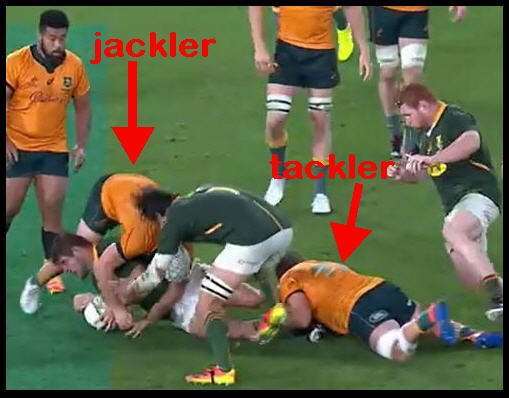You’ve probably heard rugby commentators count the phases in a Rugby Union match when a team has kept possession for a long time.
Is there a limit on how many phases a team can have? If not, why do players kick the ball away instead of holding possession for one more phase?
Let’s answer these questions. Read on…
What Is A Phase In Rugby Union?
A phase in rugby is the period when the ball is in play between two static stages of possession.
The phase can start with a kick-off, a scrum, a line-out, a tap-and-go, or the ball being moved away from a ruck.
The phase ends when a player is tackled and the team keeps possession at the breakdown.
Let’s take an example where play is restarted with a scrum. When the scrum-half passes the ball away from the scrum, that’s the start of a new phase.
The phase could also be started if the number eight picks up the ball and runs with it.
When a phase doesn’t happen
If the opposition puts pressure on the scrum and it collapses, play stops without a phase having occurred.
If the scrumhalf box kicks the ball and an opposition player catches it, then no phase has occurred.
When a phase is completed
Let’s say the scrum-half passes the ball to the outhalf who ships it onto the inside center.
The inside center is tackled to the ground. Meanwhile, the outside center and openside flanker rush to his position to protect the ball.
His teammates ruck over the ball, forming a breakdown. Unless opposition players can successfully compete for the ball while staying on their feet, the team retains possession of the ball.
This is the end of the first phase.
In the picture below the tackled player has hit the ground and an opposition player is trying to steal the ball. He is known as the jackler. Regardless of whether the jackler succeeds, the phase is completed.

Moving from phase to phase
The second phase starts when the ball is moved away from the breakdown. Again, this could be a pass, a kick, or a player breaking forward.
If the ball is kicked, then there won’t be a second phase if it’s caught by the opposition. This period of play lasted for one phase.
If the ball is passed or a player breaks forward, then there may be another breakdown. If the team retains possession, then this is the completion of a second phase.
What’s a ruck?
I’ve used the term “ruck” several times in this article. If you’re not sure what this is, check out our separate article on how rucks work in rugby.
What Are The Advantages Of A High Number Of Phases?
Some international and club teams are known for having a high number of phases as the main part of their attacking strategy.
Two contrasting philosophies

Ireland, coached by Joe Schmidt, won a Grand Slam and a Six Nations championship by holding on to the ball for many phases of play.
But coaches got wise to the strategy and by the time of the 2019 World Cup, it was no longer successful for the team in green.
In contrast, South Africa in recent years has tended to go through a small number of phases. If they haven’t broken the defensive line after a few phases, the scrum-half kicks the ball.
So, what are the main advantages of a high number of phases? Let’s run through three major advantages.
Players know what to do next
Coaches can play a structured type of play where the ball is moved from ruck to ruck according to a precise playbook.
For example, the blindside flanker may know that he is to hit every second ruck, while the outhalf starts a wide attack after the fourth breakdown.
The idea is that every player knows where they’re supposed to be on the pitch and what they’re supposed to do next.
Tired defenders make mistakes
When a team keeps possession for a high number of phases, this means that the opposition players have made tackle after tackle.
Fatigued players miss tackles or make poor decisions. They may leave too wide a gap in the defensive line. Or they may go off their feet at the next breakdown and give away a penalty.
Some teams use a strategy of many phases in the opposition twenty-two to gain a penalty. This can be very successful for the team, but it’s a real snooze-fest for the spectators.
The World Rugby authorities have tinkered with the laws at various times to discourage this.
Running down the clock

When a team has a close lead near the end of the eighty minutes of match-time, running up the phases is a common strategy.
The goal is to keep hold of the ball so that the opposition doesn’t have the chance to score.
However, referees will keep a sharp eye for any infringement by the team in possession. The sport of Rugby Union puts a high emphasis on allowing a fair contest for the ball.
If the team holding the ball is deemed to be preventing a fair contest, they’ll give away a penalty and possession.
What Are The Disadvantages Of A High Number Of Phases?
Let’s run through three major disadvantages with play a high-phase game.
After all, every team would do it if it was risk-free.
Tired forwards make mistakes
In multi-phase play, a lot of the hard work is done by the forwards to protect the ball. And they don’t just have to support the ball carrier.
Often, they’re taking short passes from the scrum-half and running into repeated tackles.
Tired forwards make mistakes. The receiver of the pass may fumble and knock on. The forward hitting the tenth ruck may get his angles wrong.
If the fatigued player enters the ruck at the side or hits a player’s head, he’ll give away a penalty.
Play bunching up on the field
With forwards moving toward repeated breakdowns to protect the ball, most of the pack can end up in one area of the field.
The effect is compounded when backs have to go into the ruck.
With dwindling options for starting a wide attack, the scrum-half or outhalf will eventually have to kick the ball and concede possession.
Predictable attack
When coaches study the attacking play of teams who favor a high phase game may start to notice definite patterns.
The team’s attack has become predictable and easier to defend.
Two Well-Known Examples Of A High Number Of Phases
Here are two well-known examples of a high number of phases in recent years.
Ireland’s 41 phases against France in 2018

Ireland won the Six Nations in 2018, but they nearly lost hold of the tournament in the first match against France in Paris.
They were behind at the end of the match but in possession of the ball. They were also in their own half.
The team in green went through a staggering 41 phases to put outhalf Jonathan Sexton into a good position to kick the drop goal.
Here’s a video of the five exhausting minutes.
Did Ireland lose to Wales despite 45 phases
A Welsh newspaper ran with this headline:
“45 phases that wowed the rugby world – the remarkable story of the greatest rearguard action in Welsh rugby history.”
Headline, Wales Online
They were referring to a match against Ireland in the 2015 Six Nations. Wales won in a thriller.
And apparently the victors get to rewrite history! Or maybe the headline writer didn’t read the actual article.
Ireland executed 32 phases (still a high number) before Wales gave away a penalty. This is an example of high phases eking out a penalty against tired defenders.
Ireland chose to kick the ball out for a lineout and start the attack again.
The writer of the article has his details right. This resets the phases back to one. Wales held Ireland out for 13 phases, but the team in green giving away a penalty.
And this is an example of tired forwards conceding possession!
Anyway, my point is that this is 32 phases followed by 13. Not 45. Sure, I’m being a little churlish here. I’m Irish, so my team lost the match!
Differences With Rugby League
The unlimited number of phases in Rugby Union is one of the main factors that make the sport different to Rugby League.
League has a restriction of six tackles before possession is turned over to the opposition. You can read more in our article on the differences between Rugby League and Rugby Union.